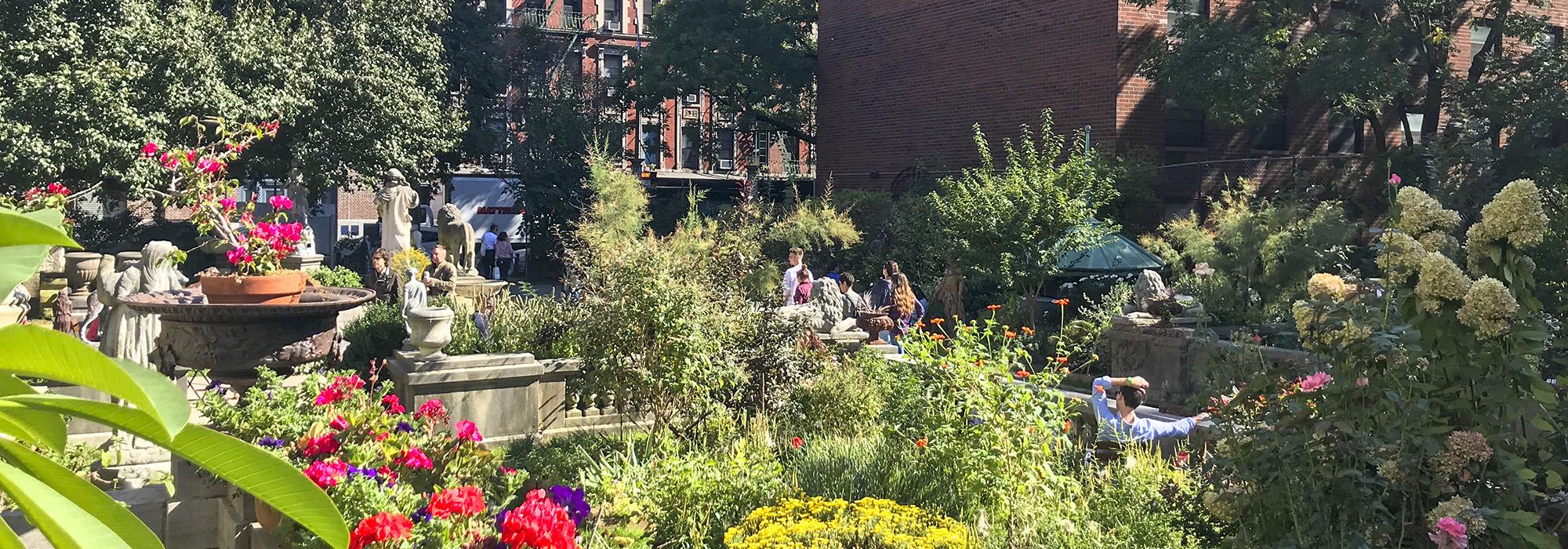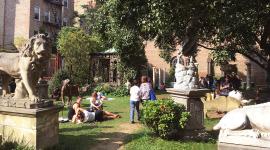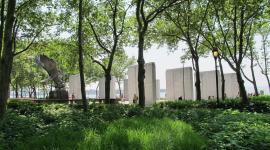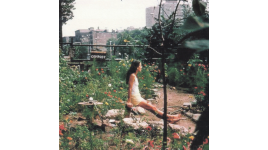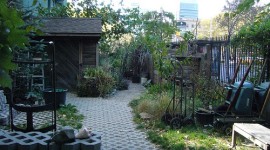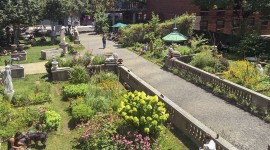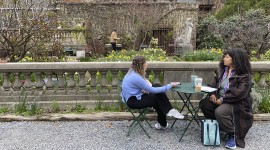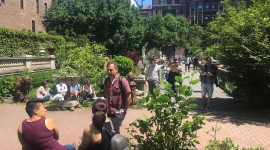Lower Manhattan’s Elizabeth Street Garden Faces Erasure
With a history of nearly 200 years as a public recreational space, the Elizabeth Street Garden is a publicly owned, privately leased community garden dotted with neoclassical statuary and nested between apartment buildings in Lower Manhattan’s North of Little Italy (Nolita) neighborhood. In 2012 the New York City Council eyed the site for new development comprising a 93,281-square-foot mixed-use complex containing affordable housing units and retail spaces. Dismissing alternative sites for the development, as well as the overwhelming community support for saving the garden (which includes more than 5,500 letters to the mayor and 8,000 petition signatures), the council now plans to proceed with the project.
History
Although the garden in its current form is only 28 years old, the property has served as an outdoor community space for public enjoyment for almost two centuries. In 1822 the Free School Society first purchased part of the current site as three lots on Mott Street to establish a public school, which would provide free classes for people of color in addition to regular schooling. Known as Public School No. 5, the space became an important community amenity, hosting lectures open to the public. Although the school was expanded in 1857 and later repaired in 1871, growing demand resulted in a larger school being built in 1904 (named Public School No.21). Plans for the new school featured additional outdoor open space for students to play and the community to gather.
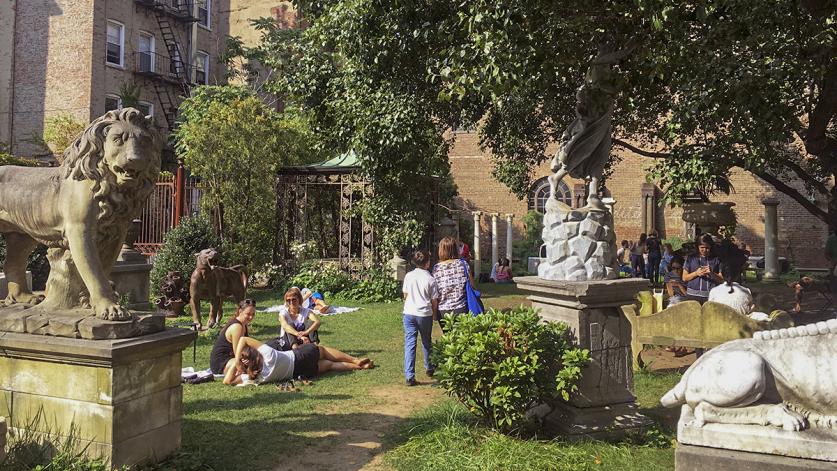
Designed by school architect Charles B. J. Snyder, the design emphasized a central courtyard that opened onto Mott Street. Equipped with an outdoor kindergarten, the site featured an enclosed terrace with a flower garden in the northeast corner of the playground for students to enjoy fresh air. The space was also used regularly as a community gathering space. By 1927 the entire city block was acquired by the Board of Education, which expanded the school, providing a larger area for recreation and public use. The school was demolished in the 1970s, leaving the entirety of Lot 41 unoccupied.
In 1981 two-thirds of former Lot 41 were developed into Little Italy Restoration Apartments (LIRA) opening onto Spring Street, with 152 affordable housing units. The remaining one-acre plot (which constitutes the garden today) was left vacant and overgrown, although designated exclusively for recreational use. Finally, in 1991 Community Board 2 resolved to lease the vacant lot to Elizabeth Street Gallery owner Allan Reiver on a month-to-month basis. Echoing the work of Elizabeth 'Liz' Christy and the Green Guerrillas from the 1970s , Reiver cleaned up the lot and planted grass, trees, and shrubs, carefully populating the garden with outdoor statues and structures from his personal collection. In 2013 a group of community members worked with Reiver to further revitalize the site, opening it to the public and increasing community engagement.
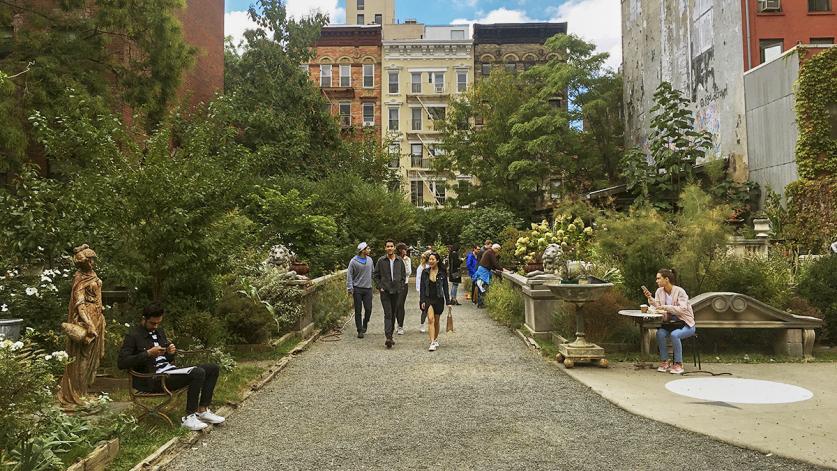
With gazebos wreathed in wrought-iron flowers, paper lanterns strung up in pear trees, cement lions perched alongside clusters of overgrown rosebushes and beds of black-eyed Susans, the garden today is an oasis in the West Village—a unique combination of whimsical statuary and lush greenery. The L-shaped plot is bisected by a gravel path that leads to a sheltered space used for public programs and exhibitions near the rear garden wall. Neighborhood volunteers operate the garden year-round and program more than 200 free educational and art-related events annually for children, seniors, and other community members.
The statuary collection includes a pair of marble columns and an iron gazebo designed by Olmsted Brothers for Burrwood (the former home of Walter Jennings) and a stone-and-granite balustrade designed by French landscape architect Jacques-Henri-Auguste Gréber. The balustrade was removed from the 36-acre Lynnewood Hall, considered to be one of the largest Gilded Age mansions in the Philadelphia area. Reiver has gifted both the gazebo and the balustrade to the garden in perpetuity. The adjacent firehouse in which the gallery is located dates to 1883 and was built by Napoleon LeBrun, official architect for the New York City Fire Department. It falls within the Chinatown and Little Italy Historic District, which is listed in the State and National Registers of Historic Places and was designated a New York City Landmark in 1998.
Threat
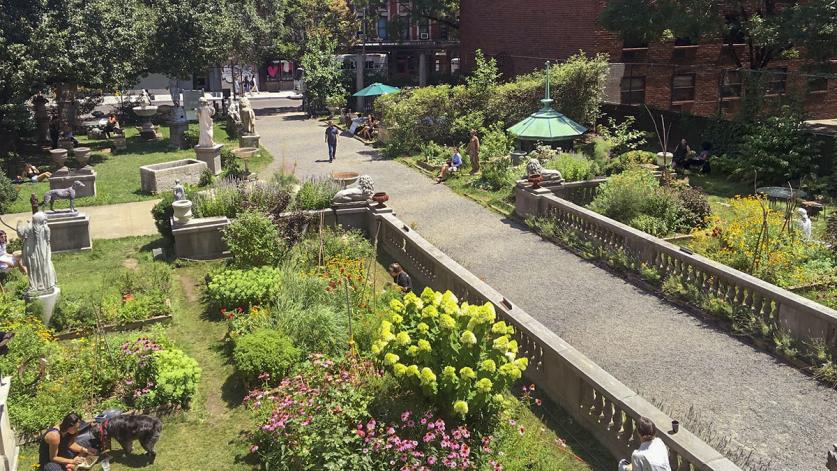
Because of the lack of available land for affordable housing in an adjacent neighborhood, (Community Board 3), the New York City Council designated the garden as a potential site for redevelopment. This effectively transferred oversight of the land from the city to the Department of Housing Preservation and Development (HPD). Dubbed Haven Green, the proposed housing project, announced at the end of 2017, would have 123 apartments and would preserve only a portion of the garden in the form of 6,700 square feet of open space. The planned green space, which, at fewer than 7,000 square feet, would be far smaller than the existing garden, would be maintained as a privately owned public space to include lawns, plantings, gardening areas, and open seating. The project currently requires the city to designate Elizabeth Street Garden as an “Urban Development Action Area,” meaning that it is an area that is or is becoming slum or blighted, constitutes a serious and growing menace, is injurious to the public welfare, and contributes increasingly to the spread of crime, juvenile delinquency and disease. The project would be developed by Pennrose Properties, Habitat for Humanity NYC—which would locate its headquarters there—and RiseBoro, the non-profit formerly known as the Ridgewood Bushwick Senior Citizens Council. The LGBTQ senior services group SAGE would also have an office at the site.
"This is a false choice; affordable housing cannot come at the expense of green public space." -New York City Comptroller Scott Stringer
While community members agree that there is a lack of affordable senior housing in the neighborhood and support projects like Essex Crossing (which includes 99 units of affordable senior housing in a new apartment building on nearby Delancey Street), many believe that minimizing the already scarce green space in the area is hardly the best solution. Instead, advocates have proposed two alternative lots for the senior housing. One potential location is a vacant 25,000–square-foot, city-owned parcel at 388 Hudson Street, where five times the number of proposed affordable units could be built.
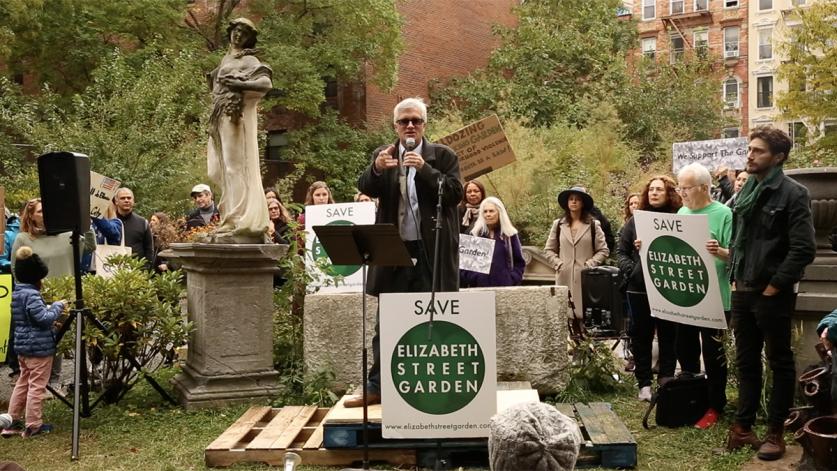
A further misconception is that only wealthy residents oppose the destruction of the garden. The crammed neighborhoods of Little Italy and SoHo, which comprise 23 percent of CB 2's population, have only three percent of the district's open space—an open-space ratio of 0.07 acres per 1,000 residents (three square feet per resident), which equates to the size of a subway seat. Aside from the garden, other open-air public spaces in the neighborhood are paved. Community meetings have seen low-income residents equally worried about losing the garden, with seniors concerned that they would be unable to walk to other parks, such as Washington Square Park, which is almost a mile away. Similarly, business owners believe that the loss will adversely affect them, as restaurants in the area serve customers who often eat their lunches in the park. Families with children who regularly use the garden and who could not afford after-school programs are also very concerned.
What You Can Do to Help
This is a time-sensitive issue. On November 13, 2018, the New York City Department of Housing Preservation and Development (HPD) sought and received certification by the City Planning Commission to begin the Uniform Land Use Review Procedure (ULURP)—a process that involves an assessment of zoning rules regarding the site, as well as community approval. Although the ULURP process may take from three to six months to complete, its commencement would be a major step towards destroying the garden, triggering test borings and other invasive measures. According to the Environmental Assessment Statement (EAS), now publicly available, the HPD has found that the project will have no significant effect on the quality of the environment, and in concluding there is no need for an in-depth Environmental Impact Statement the negative declaration appears to only address impacts regarding historic resources and hazardous material, with no mention of the loss of open, green space.
Two non-profit groups committed to saving the garden, Elizabeth Street Garden, Inc., and Friends of Elizabeth Street Garden, are coordinating legal efforts to stop its destruction. Please consider donating to the garden’s legal fund.
A public call to action has also been made to engage both supporters and community members. Please consider signing the petition or writing to Habitat New York City.
Word about the threat to the garden can also be spread using its social media accounts on Instagram (@elizabethstreetgarden), Facebook (@elizabethstreetgarden), and Twitter (@elizabethstgrdn #SaveESG #ElizabethStreetGarden)



